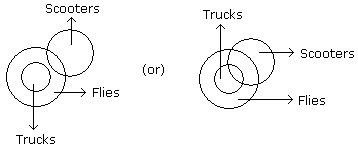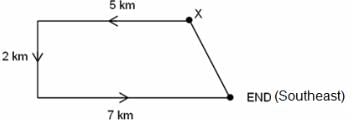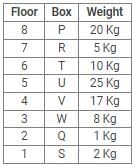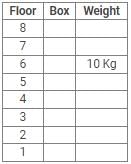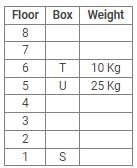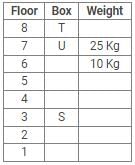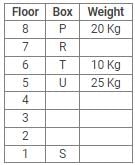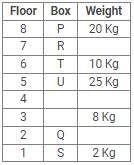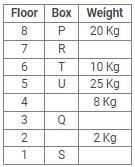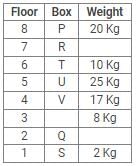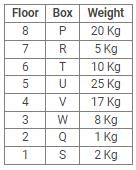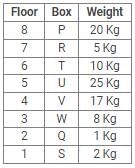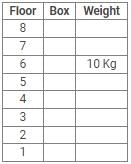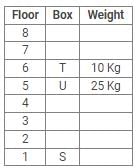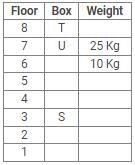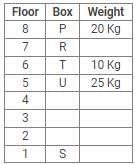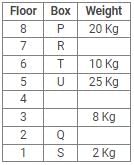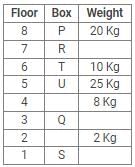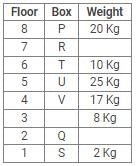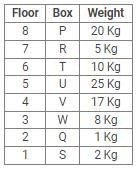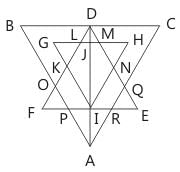SIDBI Assistant Manager Mock Test - 10 - Banking Exams MCQ
30 Questions MCQ Test - SIDBI Assistant Manager Mock Test - 10
In a classof 180, where girls are twice the number of boys. Ritesh a boy ranked thirty fourth from the top. If there are eighteen girls ahead of Rupesh how many boys are after him in rank?
Directions to Solve
In each of the following questions find out the alternative which will replace the question mark.
Question -
Paw : Cat :: Hoof : ?
Directions to Solve: In each of the questions below consists of a question and two statements numbered I and II given below it. You have to decide whether the data provided in the statements are sufficient to answer the question. Read both the statements and
Give answer:
- (A) If the data in statement I alone are sufficient to answer the question, while the data in statement II alone are not sufficient to answer the question
- (B) If the data in statement II alone are sufficient to answer the question, while the data in statement I alone are not sufficient to answer the question
- (C) If the data either in statement I alone or in statement II alone are sufficient to answer the question
- (D) If the data given in both statements I and II together are not sufficient to answer the question and
- (E) If the data in both statements I and II together are necessary to answer the question.
Question: How many pages of book X did Robert read on Sunday ?
Statements:
I.The book has 300 pages out of which two-thirds were read by him before Sunday.
II.Robert read the last 40 pages of the book on the morning of Monday.
- (A) If the data in statement I alone are sufficient to answer the question, while the data in statement II alone are not sufficient to answer the question
- (B) If the data in statement II alone are sufficient to answer the question, while the data in statement I alone are not sufficient to answer the question
- (C) If the data either in statement I alone or in statement II alone are sufficient to answer the question
- (D) If the data given in both statements I and II together are not sufficient to answer the question and
- (E) If the data in both statements I and II together are necessary to answer the question.
Statements:
I.The book has 300 pages out of which two-thirds were read by him before Sunday.
II.Robert read the last 40 pages of the book on the morning of Monday.
Directions to Solve
In each of the following questions two statements are given and these statements are followed by two conclusions numbered (1) and (2). You have to take the given two statements to be true even if they seem to be at variance from commonly known facts. Read the conclusions and then decide which of the given conclusions logically follows from the two given statements, disregarding commonly known facts.
Give answer:
- (A) If only (1) conclusion follows
- (B) If sonly (2) conclusion follows
- (C) If either (1) or (2) follows
- (D) If neither (1) nor (2) follows and
- (E) If both (1) and (2) follow.
Question -
Statements: All the trucks are flies. Some scooters are flies.
Conclusions:
- All the trucks are scooters.
- Some scooters are trucks.
Pointing to a girl Sandeep said, "She is the daughter of the only sister of my father." How is sandeep related to the girl?
Suraj started from a point X and went 5 km westwards. He then turned left and went straight for 2 km. Again, he turned left and went straight for 7 km. In which direction was he in the end with respect to point X?
Directions: In this question, two rows are given and to find out the resultant of a particular row, you need to follow the steps given below. Give answer to the question asked accordingly. The operations on numbers progress from left to right.
Step 1: If an odd number is followed by an even number, then the second number is to be subtracted from the first number.
Step 2: If an even number is followed by a composite odd number, then they are to be multiplied.
Step 3: If an even number is followed by a number which is a perfect Cube, then the even number is to be subtracted from perfect cube.
Step 4: If an even number is followed by a prime odd number, then the first number is to be divided by the second number.
Step 5: If an odd number is followed by another composite (a non-prime number) odd number, then they are to be added.
Q. Find the resultant of the second row, if N is the resultant of the first row.

Directions: Study the following information carefully and answer the questions given below:
Eight boxes – P, Q, R, S, T, U, V and W were placed in an almirah of eight shelves. The bottom shelf was numbered 1 and the topmost shelf was numbered 8. Each of these boxes contained different amount of Sugar – 25 kg, 20 kg, 17 kg, 10 kg, 8 kg, 5 kg, 2 kg and 1 kg but not necessarily in the same order.
Box V was placed at one of the even numbered shelves and contained 17 kg of Sugar. The box which was placed on 6th shelf contained 10 kg of Sugar. Box Q was placed immediately below the box which contained 8 kg of Sugar and immediately above the box which contained 2 kg of Sugar. Box R was not the lightest and Box U, was the heaviest. Box R was placed above the shelf on which Box U was placed but not on the even numbered shelf. Box P, contained 20 kg of Sugar, and was placed either at the top or bottom shelf. There are three boxes between Box U and Box S and Box S was placed below the shelf on which Box U was placed. T was placed immediately above the box which was heaviest.
Q. What amount of Sugar was contained by Box Q?
Directions: Study the following information carefully and answer the questions given below:
Eight boxes – P, Q, R, S, T, U, V and W were placed in an almirah of eight shelves. The bottom shelf was numbered 1 and the topmost shelf was numbered 8. Each of these boxes contained different amount of Sugar – 25 kg, 20 kg, 17 kg, 10 kg, 8 kg, 5 kg, 2 kg and 1 kg but not necessarily in the same order.
Box V was placed at one of the even numbered shelves and contained 17 kg of Sugar. The box which was placed on 6th shelf contained 10 kg of Sugar. Box Q was placed immediately below the box which contained 8 kg of Sugar and immediately above the box which contained 2 kg of Sugar. Box R was not the lightest and Box U, was the heaviest. Box R was placed above the shelf on which Box U was placed but not on the even numbered shelf. Box P, contained 20 kg of Sugar, and was placed either at the top or bottom shelf. There are three boxes between Box U and Box S and Box S was placed below the shelf on which Box U was placed. T was placed immediately above the box which was heaviest.
Q. Which of the following combinations is correct?
Direction: In each question below is given a statement followed by two conclusions numbered I and II. You have to assume everything in the statement to be true, then consider the two conclusions together and decide which of them logically follows beyond a reasonable doubt from the information given in the statement.
Statements: Any student who does not behave properly while in the school brings bad name to himself and also for the school.
Conclusions:
- Such student should be removed from the school.
- Stricter discipline does not improve behaviour of the students.
Direction: In each question below is given a statement followed by two conclusions numbered I and II. You have to assume everything in the statement to be true, then consider the two conclusions together and decide which of them logically follows beyond a reasonable doubt from the information given in the statement.
Statements: Applications of applicants who do no fulfil eligibility criteria and/or who do not submit applications before last date will be summarily rejected and will not be called for the written test.
Conclusions:
- Those who are called for the written test are those who fulfil eligibility criteria and have submitted their applications before last date.
- Written test will be held only after scrutiny of applications.
Directions: Read the following information carefully and answer the questions.
Alex, Bravo, Charlie, Delta, Echo and Foxtrot joined six different colleges – UBS, SP JAIN, DAVIET, JBIMS, IIMA and IIMB and opted for six different courses in management – Marketing, Finance, Operations, HR, Logistics and General Management.
Each of them has a different educational qualification out of B. Tech, B.Sc, B.Com, C.A, BBM and BA.
The following information is available about them:
- Delta joined SP JAIN and did not take up Marketing or Logistics and is not a B. Tech.
- The person who joined IIMA opted for HR and is not a C.A or B.Sc.
- Foxtrot is a C.A and has taken Finance management.
- The person, who is a B.A graduate, joined JBIMS and took Logistics. Whereas, the person, who is a B.Com graduate, took up General Management.
- The person, who is a B. Tech graduate, has taken Operations Management and did not join UBS or DAVIET.
- Alex joined IIMB, Charlie is B.A graduate and Bravo took up HR.
Q. Which of the following persons joined IIMA?
Find the number of triangles in the given figure.
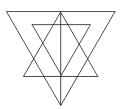
How many days did Bhawna take to complete his work?
I. Preeti correctly remembers that Bhawna took more than 4 days but less than 11 days to complete the work.
II. Kirti correctly remembers that Bhawna took more than 9 days but less than 15 days to complete the work.
What is the code of ‘7’ in a certain code?
I. ‘734’ stands for ‘DH%’ and ‘348’ stands for ‘D*%’ in that code.
II. ‘127’ stands for ‘H*$’ and ‘375’ stands for ‘&@H’ in that code.
Directions: Study the following bar chart carefully and answer the questions given beside.
The following graph shows the percentage break-up of sales of units of different products in 2018.

Product A is sold at Rs.40/unit. The shopkeeper earns Rs.18000 from product A.
Q. The shopkeeper made Rs. 25 profit on each unit of product B. How much profit did the shopkeeper make?
Directions: Study the following information carefully and answer the questions given beside.
Aman, Binoy and Chintu are three friends who go out to explore the city. They ate their breakfast, lunch and dinner in the market and split the total bill. The amount spent by Aman on breakfast and lunch is in the ratio 3 : 4, while that spent by Chintu on lunch and dinner is in the ratio 11 : 7.
The amount paid by Aman on Dinner and Chintu on breakfast is equal. In lunch, the share of Binoy is the average of Aman and Chintu. The money spent by Aman on Breakfast and lunch is 700/9% of the money spent by Chintu on lunch and dinner. The ratio of breakfast, lunch and dinner in the total bill is 58 : 57 : 65. In the end Aman gives Chintu Rs. 20, to make the share of each of them equal.
Q. What is the difference between the total amount spent on breakfast and dinner?
Directions: Study the following information carefully and answer the questions given beside.
Aman, Binoy and Chintu are three friends who go out to explore the city. They ate their breakfast, lunch and dinner in the market and split the total bill. The amount spent by Aman on breakfast and lunch is in the ratio 3 : 4, while that spent by Chintu on lunch and dinner is in the ratio 11 : 7.
The amount paid by Aman on Dinner and Chintu on breakfast is equal. In lunch, the share of Binoy is the average of Aman and Chintu. The money spent by Aman on Breakfast and lunch is 700/9% of the money spent by Chintu on lunch and dinner. The ratio of breakfast, lunch and dinner in the total bill is 58 : 57 : 65. In the end Aman gives Chintu Rs. 20, to make the share of each of them equal.
Q. The amount spent by Aman on breakfast, Binoy on lunch and Chintu on dinner is what percent of the total expenditure of all three?
Directions: In the following question, study the two pie-charts and answer the questions.
April Month's Salary = Rs. 24000.
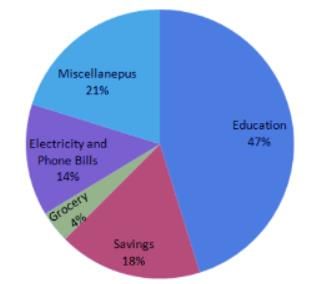
May Month's Salary = Rs. 25000.
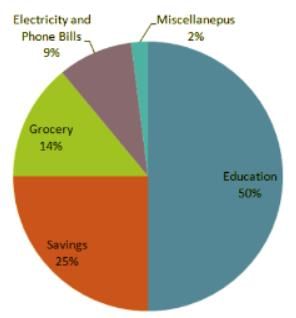
Q. The ratio of amount spent for saving in April month’s salary and miscellaneous in May month’s salary is-
If sentence (3), 'India must be mindful, therefore, that in welcoming the U.S.'s categorisations of its security threats, it doesn't unthinkingly get swept into an American clinch' is the first sentence, what is the order of other sentences after rearrangement?
1. It would be wise to await a stabilisation in Mr. Trump's policies, or at least concrete action to back its words.
2. While the U.S. strategy deals with global concerns, the past year has seen American withdrawal from pacts ranging from the Trans-Pacific Partnership to the Paris agreement on climate change.
3. India must be mindful, therefore, that in welcoming the U.S.'s categorisations of its security threats, it doesn't unthinkingly get swept into an American clinch.
4. For example, while the U.S. has talked of countering China's influence in South Asia, it has not backed this with actual financial assistance for infrastructure critical to the region.
5. To begin with, the U.S. articulation of its perceived challenges has swung wildly over the past year of the Trump administration.
6. Equally, while Mr. Trump's words on Pakistan and terrorism are sharp, the U.S. has yet to show its hand, either in terms of military action or withholding of coalition support funds.
Directions: Starter to the following paragraph has been correctly provided in statement I. However, the other sentences in the paragraph have been jumbled up. Rearrange the sentences, such as to make coherent sense.
I. We all know that savage nations accompany their dances by striking one object with another, sometimes by a clanking of stones, the pounding of wood, or perhaps the clashing of stone spearheads against wooden shields, meaning thus to express something that words cannot.
A. This more or less rhythmic clanking of stones together, the striking of wooden paddles against the side of a canoe, or the clashing of stone spearheads against wooden shields, could not constitute the first musical instrument, but certainly the first lessons in the human sense of of rhythm.
B. The sense of rhythm is highly developed even among those savage tribes which stand the lowest in the scale of civilization to-day.
C. This meaning changed naturally from its original one of being the simple expression of fear to that of welcoming a chieftain; we may still see a shadowy reminiscence of it in the manner in which the violinists of an orchestra applaud an honoured guest at one of our symphony concerts by striking the backs of their violins with their bows.
D. While this clashing of one object against another could not be called the beginning of music, and while it could not be said to originate a musical instrument, it did, nevertheless, bring into existence music's greatest prop, rhythm, an ally without which music would seem to be impossible.
Direction: Read the following passage carefully and answer the question that follows.
The passage of a statutory resolution and a Bill in Parliament — “abrogating” Article 370 which confers special political status on Jammu and Kashmir, and bifurcating the State into two Union Territories — has robbed the Kashmir Valley of its political autonomy, or whatever remains of it after all these years. It may deepen the State’s trust deficit vis-a-vis the Centre. The “abrogation” of Article 370, being hailed as a “glorious” move, is itself a misnomer. “Amending” or “abrogating” Article 370 is a Constitutional improbability; the amending provision of Article 368 says no Constitutional amendments have effect in relation to J&K unless applied by Order of the President under Article 370 that requires the concurrence of the State’s legislature and ratification by its Constituent Assembly.
The moves on Monday can be seen as an exercise in political optics, pandering to a certain majoritarian sentiment. What the Centre has done is to shred even the garb of democracy and spirit of dialogue that successive governments felt was important to engage the people of Kashmir. Through as many as 45 Presidential Orders, the most critical being the Order of 1954, Article 370 has already been divested of its spirit. Secessionist elements and some Indian Constitutional experts have cited this gradual advance of the Union as the conquest of the Valley by stealth.
What even this controversial process of assimilation, with Article 370 in place, has done is to achieve the growth of local political engagement. It legitimises a pan-Indian sentiment in the Valley where the secessionists would like to portray India as a mere occupational force. Indeed, there are several other provisions in the Constitution such as Article 371(A), 371(G), 371(B), 371(C) that validate indigenous political forces in States like Nagaland, Mizoram, Assam, Manipur et al. This asymmetric form of federalism has its global parallels in the substantial autonomy enjoyed by Scotland and Wales and Northern Ireland within Great Britain. The protests in Hong Kong affirm the relevance of democratic processes inherent in the one country-two systems followed even by China.
By robbing Article 370 of its special provisions, the BJP has undermined these nuanced and extremely critical democratic processes. Simultaneously, the State has been carved up into two Union Territories with J&K having a legislature and Ladakh without it. The unprecedented step of reorganising a State and divesting it of its legislative authority without even a semblance of consultation with the stakeholders sets a dangerous precedent underlined by several regional groups and political parties, particularly the DMK and the MDMK. It is possible that the BJP would reap rich political dividends for this muscular policy. But the Centre would be responsible for escalation of violence in the Valley where all doors for political engagement and democratic exchange seem to have been closed down for good. Without meaningful participation of the people, any such unilateral integration can remain at best territorial.
Q. Which among the following is correct regarding the Article 368 in the Constitution of India, as stated in the passage?
Directions: Read the passage carefully and answer the questions that follow:
There is now no denying that the new government takes office amid a clear economic slowdown. The first macro data set released showed an under-performing economy with GDP growth falling to 5.8% in the fourth quarter of 2018-19 and pulling down the overall growth for the fiscal to a five-year low of 6.8%. Growth in gross value added (GVA), which is GDP minus taxes and subsidies, fell to 6.6% in 2018-19, pointing to a serious slowdown. If further confirmation were needed, the growth in core sector output — a set of eight major industrial sectors — fell to 2.6% in April, compared to 4.7% in the same month last year. And finally, unemployment data, controversially suppressed by the Union government so far, showed that joblessness was at a 45-year high of 6.1% in 2017-18. These numbers highlight the challenges ahead in drafting the Budget for 2019-20. The economy is beset by a consumption slowdown as reflected in the falling sales of everything from automobiles to consumer durables, even fast-moving consumer goods. Private investment is not taking off, while government spending, which kept the economy afloat during the last NDA government, was cut back in the last quarter of 2018-19 to meet the fiscal deficit target of 3.4%.
The good news is that inflation is undershooting the target and oil prices are on the retreat again. But the rural economy remains in distress, as seen by the 2.9% growth in agriculture last fiscal; the sector needs a good monsoon this year to bounce back. Overall economic growth in the first quarter of this fiscal is likely to remain subdued, and any improvement is unlikely until the late second quarter or the early third. There are not too many options before the new Finance Minister. In the near term, she has to boost consumption, which means putting more money in the hands of people. That, in turn, means cutting taxes, which is not easy given the commitment to rein in the fiscal deficit. In the medium term, Ms. Sitharaman has to take measures to boost private investment even as she opens up public spending again. These call for major reforms, starting with land acquisition and labour, corporate taxes by reducing exemptions and dropping rates, and nursing banks back to health. On the table will be options such as further recapitalisation of the ailing banks, and consolidation. The question, though, is where the money will come from. With tax revenues likely to be subdued owing to the slowdown, the Centre will have to look at alternative sources such as disinvestment. There may be little choice but to go big on privatisation. A rate cut by the Reserve Bank of India, widely expected this week, would certainly help boost sentiment. But it is the Budget that will really set the tone for the economy
Q. As per the passage, which of the following reforms has NOT been mentioned in the passage to improve the investment climate?
Directions: Read the passage carefully and answer the questions that follow:
There is now no denying that the new government takes office amid a clear economic slowdown. The first macro data set released showed an under-performing economy with GDP growth falling to 5.8% in the fourth quarter of 2018-19 and pulling down the overall growth for the fiscal to a five-year low of 6.8%. Growth in gross value added (GVA), which is GDP minus taxes and subsidies, fell to 6.6% in 2018-19, pointing to a serious slowdown. If further confirmation were needed, the growth in core sector output — a set of eight major industrial sectors — fell to 2.6% in April, compared to 4.7% in the same month last year. And finally, unemployment data, controversially suppressed by the Union government so far, showed that joblessness was at a 45-year high of 6.1% in 2017-18. These numbers highlight the challenges ahead in drafting the Budget for 2019-20. The economy is beset by a consumption slowdown as reflected in the falling sales of everything from automobiles to consumer durables, even fast-moving consumer goods. Private investment is not taking off, while government spending, which kept the economy afloat during the last NDA government, was cut back in the last quarter of 2018-19 to meet the fiscal deficit target of 3.4%.
The good news is that inflation is undershooting the target and oil prices are on the retreat again. But the rural economy remains in distress, as seen by the 2.9% growth in agriculture last fiscal; the sector needs a good monsoon this year to bounce back. Overall economic growth in the first quarter of this fiscal is likely to remain subdued, and any improvement is unlikely until the late second quarter or the early third. There are not too many options before the new Finance Minister. In the near term, she has to boost consumption, which means putting more money in the hands of people. That, in turn, means cutting taxes, which is not easy given the commitment to rein in the fiscal deficit. In the medium term, Ms. Sitharaman has to take measures to boost private investment even as she opens up public spending again. These call for major reforms, starting with land acquisition and labour, corporate taxes by reducing exemptions and dropping rates, and nursing banks back to health. On the table will be options such as further recapitalisation of the ailing banks, and consolidation. The question, though, is where the money will come from. With tax revenues likely to be subdued owing to the slowdown, the Centre will have to look at alternative sources such as disinvestment. There may be little choice but to go big on privatisation. A rate cut by the Reserve Bank of India, widely expected this week, would certainly help boost sentiment. But it is the Budget that will really set the tone for the economy
Q. As per the passage, which of the following would lead to ‘putting more money in the hands of people’?
I. Decrease in tax rates.
II. Increase in inflation
III. Increase in private investment
The gas usually causing explosions in coal mines is –
RBI has five wholly-owned subsidiaries. Which of the following is not a subsidiary of RBI?
Which bank has introduced the first Micro ATM across India?
Which global organization has appointed Sirisha Voruganti as the CEO and Managing Director of its Lloyds Technology Center in India?
Where is the Urban-20 Mayoral Summit taking place under India's G20 presidency?
Which film director was presented with the British National Award for Best Director?



